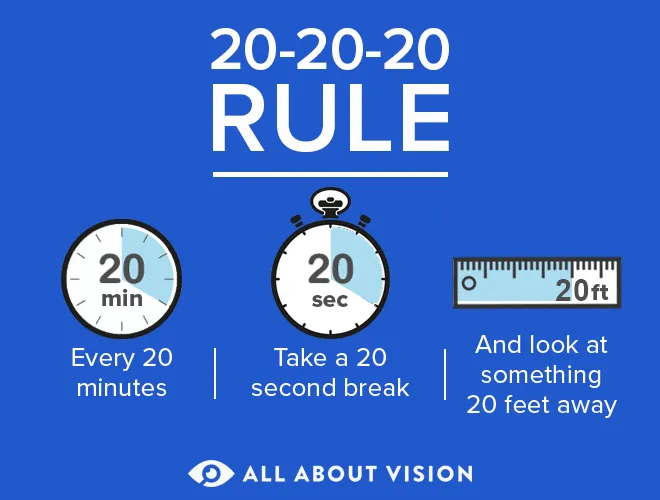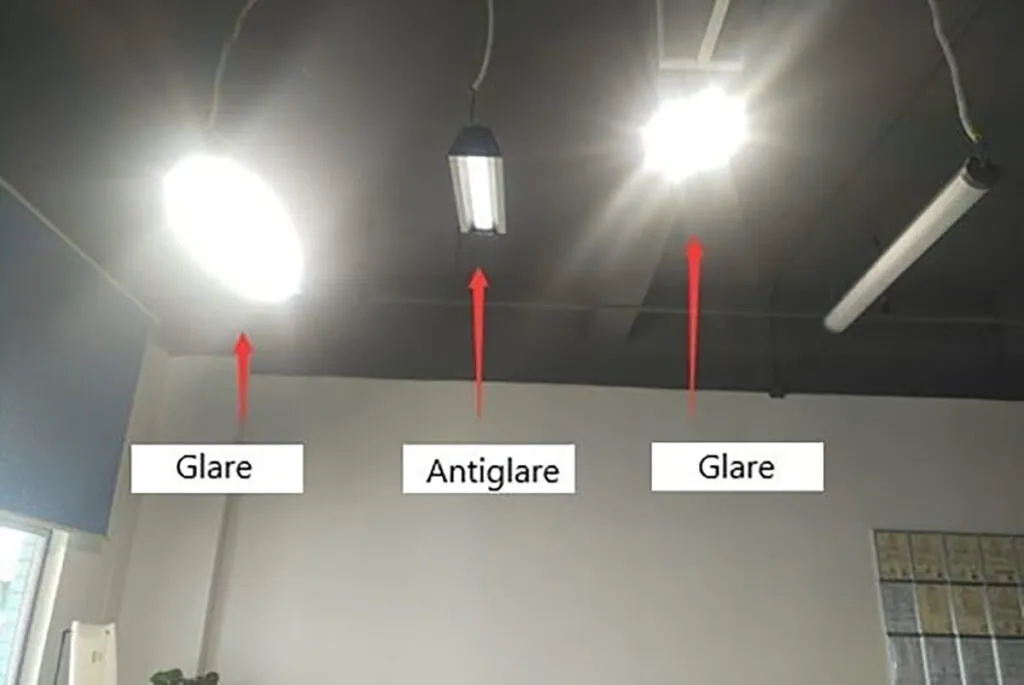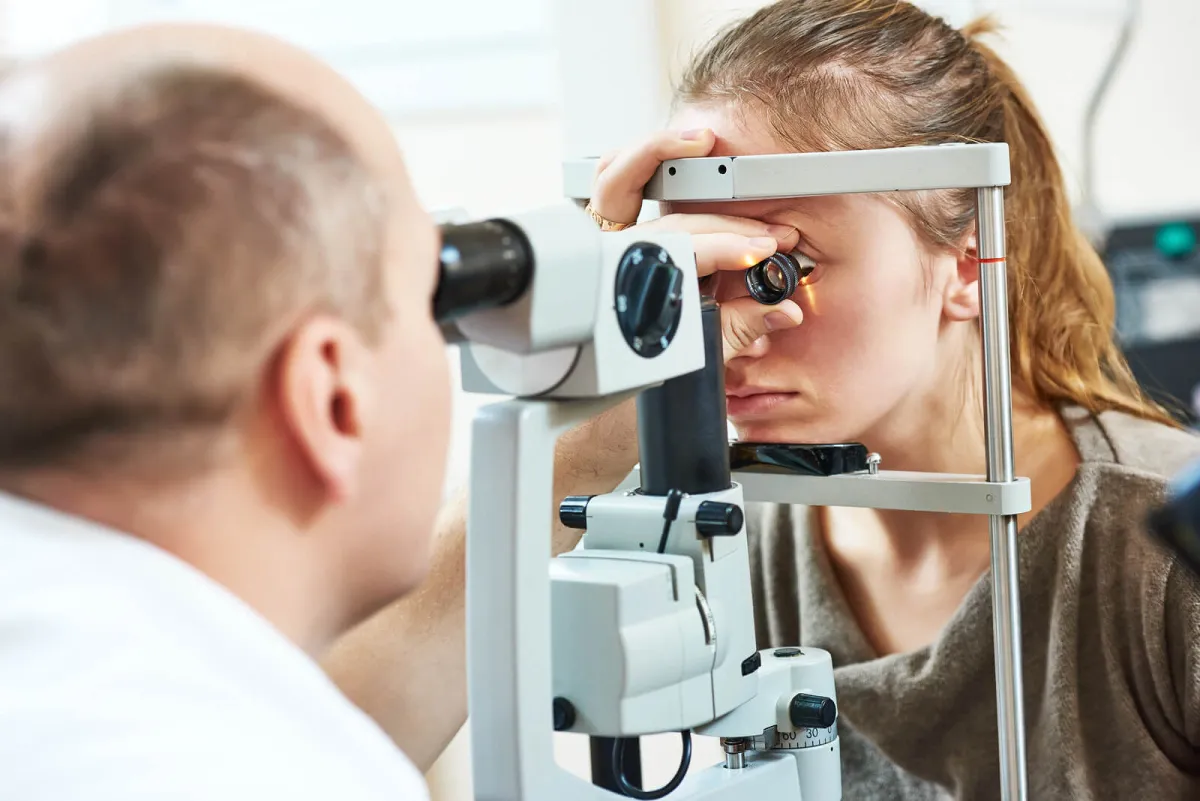Office Wellness
Maintaining Eye Health at Work
FSDAVCFEBFEVSDDVFSD
FSDAVCFEBFEVSDDVFSD
FSDAVCFEBFEVSDDVFSD
The 20-20-20 Rule
The 20-20-20 rule is a simple yet effective technique to prevent eye strain, especially prevalent among office workers who spend long periods staring at screens. This rule suggests taking a 20-second break to look at an object at least 20 feet away every 20 minutes. This short break helps relax the eye muscles, which can become strained from prolonged screen viewing and contribute to computer vision syndrome.
Implementing this rule can significantly alleviate the discomfort associated with continuous computer use. Allowing the eyes to refocus at a distance, helps interrupt the strain cycle, providing essential relief and contributing to long-term eye health. Encouraging this habit in the workplace can enhance overall productivity and well-being by maintaining sharper focus and preventing the fatigue that often accompanies extensive screen time.
The 20-20-20 rule is a simple yet effective technique to prevent eye strain, especially prevalent among office workers who spend long periods staring at screens. This rule suggests taking a 20-second break to look at an object at least 20 feet away every 20 minutes. This short break helps relax the eye muscles, which can become strained from prolonged screen viewing and contribute to computer vision syndrome.

Implementing this rule can significantly alleviate the discomfort associated with continuous computer use. Allowing the eyes to refocus at a distance, helps interrupt the strain cycle, providing essential relief and contributing to long-term eye health. Encouraging this habit in the workplace can enhance overall productivity and well-being by maintaining sharper focus and preventing the fatigue that often accompanies extensive screen time.

Workspace Ergonomics
Proper workspace ergonomics are critical in minimizing eye strain for office workers. The position of your computer screen plays a significant role in this. Ideally, the screen should be placed about 20 to 24 inches away from the eyes and just slightly below eye level. This arrangement helps reduce the need for your eyes to refocus too frequently, which can cause significant eye fatigue over time. It also helps in maintaining a posture that prevents neck and back pain, further contributing to overall comfort and health while working.
In addition to screen placement, the lighting in your office can greatly affect eye health. Office lighting should be tailored to reduce glare on computer screens, which can lead to squinting and increased strain. Positioning monitors away from direct light sources like windows and using blinds or curtains to control natural light can help achieve this. Additionally, using desk lamps with adjustable brightness can provide adequate light without contributing to glare, making it easier to read documents or view your screen without straining your eyes.
Furthermore, investing in an ergonomic chair can significantly improve your seating posture and reduce the risk of eye strain. Chairs should support the curve of your spine, and allow you to sit with your feet flat on the floor and your arms at a comfortable angle for typing. This setup not only aids in reducing strain on your eyes but also promotes better overall body health by facilitating proper blood flow and reducing muscle fatigue throughout the workday.
Anti-Glare and Lighting

Using anti-glare screens is essential in minimizing eye strain for those who spend extensive hours in front of a computer. These screens help reduce the glare that reflects from the background or overhead lighting, which can cause significant discomfort and eye fatigue. Proper placement and use of anti-glare screens can lead to a noticeable reduction in the symptoms associated with computer eye strain.
Proper lighting in the office is equally important as the use of anti-glare screens. It's vital to ensure that the lighting complements the workspace without overpowering it.
It's recommended to position computer screens away from direct light sources such as windows or overhead lights that can cause a reflection on the screen. Additionally, using desk lamps with adjustable brightness settings can help you customize the lighting according to the task at hand and the time of day, which is particularly beneficial for maintaining good eye health and comfort.
Using anti-glare screens is essential in minimizing eye strain for those who spend extensive hours in front of a computer. These screens help reduce the glare that reflects from the background or overhead lighting, which can cause significant discomfort and eye fatigue. Proper placement and use of anti-glare screens can lead to a noticeable reduction in the symptoms associated with computer eye strain.
Proper lighting in the office is equally important as the use of anti-glare screens. It's vital to ensure that the lighting complements the workspace without overpowering it.

Task lighting should be considered to illuminate specific work areas without adding glare or shadows over your workspace. This type of lighting is often overlooked but can significantly improve visual comfort by providing focused light where it's needed most. Consider the color temperature of your lighting solutions; opting for warmer tones can reduce the blue light exposure, which is known to contribute to eye strain and disrupt sleep patterns.
It's recommended to position computer screens away from direct light sources such as windows or overhead lights that can cause a reflection on the screen. Additionally, using desk lamps with adjustable brightness settings can help you customize the lighting according to the task at hand and the time of day, which is particularly beneficial for maintaining good eye health and comfort.
Task lighting should be considered to illuminate specific work areas without adding glare or shadows over your workspace. This type of lighting is often overlooked but can significantly improve visual comfort by providing focused light where it's needed most. Consider the color temperature of your lighting solutions; opting for warmer tones can reduce the blue light exposure, which is known to contribute to eye strain and disrupt sleep patterns.
Hydration and Humidity
Maintaining eye hydration is crucial in office environments, particularly those that are air-conditioned, which can significantly dry out the air. Using a humidifier in your workspace can help add necessary moisture back into the air, preventing your eyes from becoming dry and irritated. This is especially beneficial for those who experience dry eye symptoms, as it helps maintain a more comfortable and visually efficient work environment.
Artificial tears are another effective solution for maintaining eye hydration, providing immediate relief from dryness and discomfort. Regular use of these lubricating eye drops can help sustain moisture levels in the eyes, improving overall eye comfort and health. Incorporating these practices into your daily routine can significantly enhance your office eye wellness, ensuring your eyes remain hydrated and less prone to strain throughout the workday.
Regular Eye Exams
Regular eye exams are essential for preventing eye strain and ensuring overall eye health, especially for those who work long hours in front of computer screens. These exams help detect early signs of eye strain, computer vision syndrome, and other related conditions before they become serious. By catching issues early, optometrists can provide effective treatments or recommend changes in your vision care routine to mitigate symptoms.
In addition to detecting problems early, regular eye check-ups ensure that any corrective eyewear is adequately suited to current needs, as prescriptions can change over time. This is crucial for maintaining clear vision and reducing the risk of eye strain, which can significantly impact productivity and comfort in the workplace. Employers can aid this effort by providing vision care benefits and encouraging a culture where eye health is a priority.
Regular eye exams are essential for preventing eye strain and ensuring overall eye health, especially for those who work long hours in front of computer screens. These exams help detect early signs of eye strain, computer vision syndrome, and other related conditions before they become serious. By catching issues early, optometrists can provide effective treatments or recommend changes in your vision care routine to mitigate symptoms.

In addition to detecting problems early, regular eye check-ups ensure that any corrective eyewear is adequately suited to current needs, as prescriptions can change over time. This is crucial for maintaining clear vision and reducing the risk of eye strain, which can significantly impact productivity and comfort in the workplace. Employers can aid this effort by providing vision care benefits and encouraging a culture where eye health is a priority.

Eye Health Tips
To reduce computer eye strain, it's important to integrate simple but effective habits into your daily routine. One beneficial practice is performing blinking exercises throughout the day. Regular blinking helps to moisten the eyes, preventing dryness and irritation that often come from prolonged screen time. Aim to blink intentionally every 20 minutes when working on the computer, as this can significantly alleviate eye discomfort. Hydration plays a crucial role in maintaining eye health. Drinking adequate water throughout the day helps to keep the body and eyes well-hydrated, supporting overall eye function and helping to reduce symptoms of dry eyes. Keeping a water bottle at your desk as a constant reminder to drink water can be a practical step towards better hydration.
Dietary choices also impact eye health significantly. Include foods rich in omega-3 fatty acids, Vitamin C, E, and beta-carotene in your diet to support eye health. Foods like fish, nuts, citrus fruits, and leafy green vegetables contribute to stronger vision and may reduce the risk of chronic eye diseases. Additionally, consider supplements specifically designed to support eye health if your daily intake lacks these nutrients.
Lastly, adjust your computer’s display settings to reduce eye strain. Increase the text size for easier reading and adjust the brightness to a level that feels comfortable to your eyes. Make sure the color temperature of your display is not too harsh—warmer tones are easier on the eyes than cooler ones. These adjustments can make a significant difference in how your eyes feel at the end of the day.
Vision Insurance Benefits
Utilizing vision insurance is a proactive step in maintaining optimal eye health, especially for office workers. Vision insurance typically covers regular eye check-ups, which are vital for detecting early signs of eye strain, fatigue, and other visual impairments. Regular visits to the eye doctor can ensure that any vision problems are addressed promptly, significantly contributing to workplace eye safety and overall well-being.


Utilizing vision insurance is a proactive step in maintaining optimal eye health, especially for office workers. Vision insurance typically covers regular eye check-ups, which are vital for detecting early signs of eye strain, fatigue, and other visual impairments. Regular visits to the eye doctor can ensure that any vision problems are addressed promptly, significantly contributing to workplace eye safety and overall well-being.
These benefits also often extend to treatments and corrective eyewear, making them more affordable and accessible. For employers, providing vision insurance encourages a healthier workforce, reducing overall downtime and productivity loss due to eye-related issues. It also underscores a commitment to employee health, which can enhance job satisfaction and retention.
These benefits also often extend to treatments and corrective eyewear, making them more affordable and accessible. For employers, providing vision insurance encourages a healthier workforce, reducing overall downtime and productivity loss due to eye-related issues. It also underscores a commitment to employee health, which can enhance job satisfaction and retention.
Schedule Your Eye Exam Today
Take the first step towards safeguarding your vision by scheduling an eye exam at Kleinwood Vision. Regular eye exams are essential not only for updating your prescriptions but also for catching potential eye health issues before they develop into serious problems. An early diagnosis can be crucial in implementing effective treatments that maintain your eye health and overall well-being.
We understand the demands of office work and how it can affect your eyes. That's why we focus on providing tailored eye care solutions that address specific concerns related to prolonged screen use. By visiting Kleinwood Vision, you can ensure that your eye health is in the best hands, allowing you to continue your work with comfort and confidence. Don't wait until you experience discomfort—book your appointment today to take a proactive step toward long-term eye wellness.

Contact Info
Hours of Operation
Mon - Fri | 9:00 AM - 5:00 PM
Sat - Sun | Closed
Holiday Hours: We are closed for the following holidays: New Years Day, Memorial Day, Independence Day, Labor Day, Thanksgiving Day, Christmas Day
© 2025 Kleinwood Vision. All rights Reserved.


